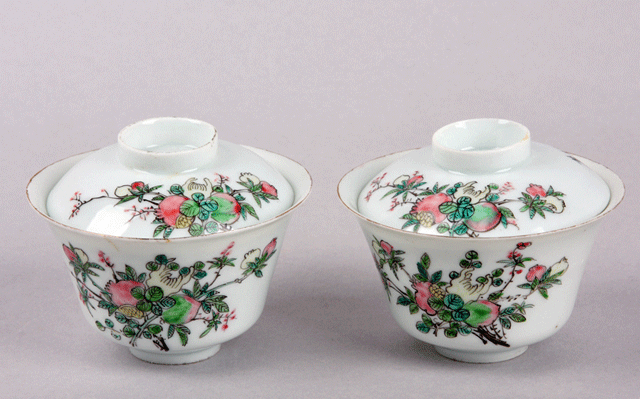
A gaiwan is the simple bowl, lid and saucer that is often used to brew loose-leaf tea. The name says it all: gaiwan translates literally into "lid-bowl."
Many tea historians believe that the gaiwan evolved from the chawan, or “tea bowl,” which has been used in China since the Tang Dynasty (618-907). The famous tea expert and writer Lu Yu, author of The Classic of Tea, is credited with creating the chawan, which became widely popular during the Tang Dynasty. The use of chawan eventually spread to Japan, where it is still used in the traditional Japanese matcha tea ceremony. However, the gaiwan did not develop from the chawan and become widely used in China until the Ming Dynasty (1368-1644).
The popularity of the gaiwan mirrors the evolution of tea itself. It took several hundred years for the chawan to evolve into the gaiwan because loose tea leaves did not become popular until the Ming Dynasty. Before the Ming Dynasty, most tea in China came in various powdered forms. Although the quality of these powdered teas was likely questionable, this easily transportable form was essential to the spread of tea and tea culture.
[Read more about the evolution of tea preparation in this previous post]
In China, loose tea leaves finally came into fashion during the Ming Dynasty when the Imperial Court created a law dictating that only high quality, loose leaf tea could be offered as gifts to the emperor. The general population began to drink this type of tea as well. Eventually, the older tea brewing methods and utensils used with powdered tea fell out of favor.
The modern tea brewing technique was created after this shift towards whole leaf tea. Tea was brewed by pouring hot water over the leaves inside of a vessel. A strainer of some sort was needed to remove the steeped tea leaves. The modern teapot and gaiwan were created.
The gaiwan was originally intended to be used for drinking tea. When drinking from a gaiwan, you simply bring the cup to your lips and use the lid to prevent the leaves from entering your mouth.

In the modern day, gaiwans are often used as a brewing vessel, with the decanted tea being served in a separate cup. The lid is held against the cup so that the leaves are filtered out. This straining takes a surprising amount of skill, since all three parts of the gaiwan are held at once and are filled with extremely hot water. For this reason, I have grown particularly fond of the “spouted gaiwan” style. These gaiwans have a raised lip that runs around the top, making the piece much easier to handle and use.
Since gaiwans are glazed (and therefore nonporous) they are something close to the ideal brewing vessel for green and white teas. Most gaiwans are made from porcelain or glass, but they can also be made from stone, Yixing clay or jade. These materials impart the tea with no additional flavors, allowing the more delicate flavors of green and white teas to really show.

Gaiwans can also be used to brew oolong and puerh teas, since they are very convenient for brewing multiple infusions. However, gaiwans are not recommended for black teas because the surface area is too large, thus making the water too cold for an ideal cup of black tea.
A gaiwan is one of the most versatile pieces of tea equipment, and a must-have for any tea enthusiast.
